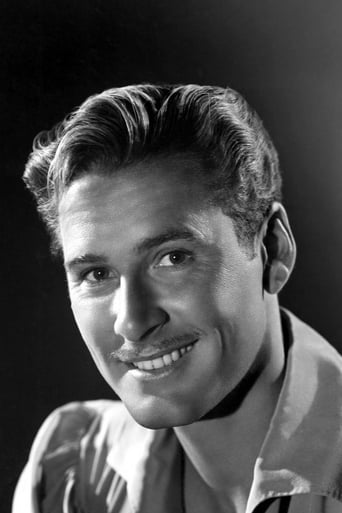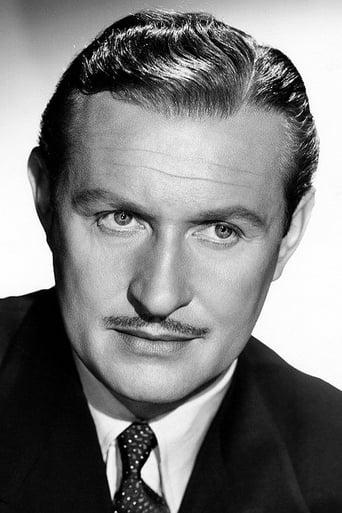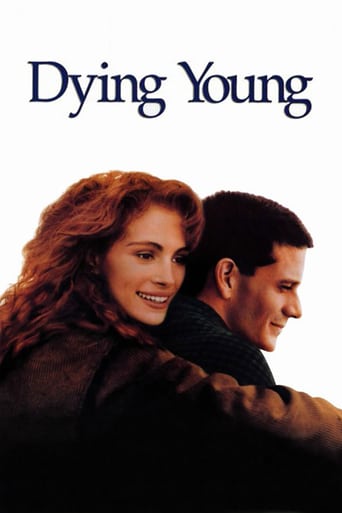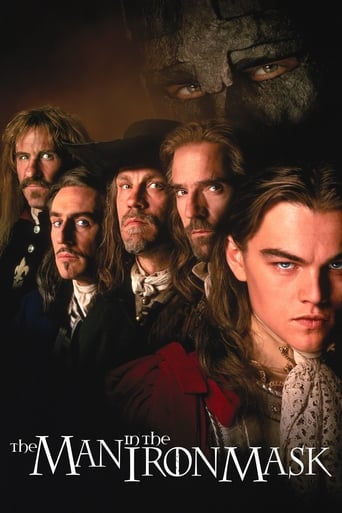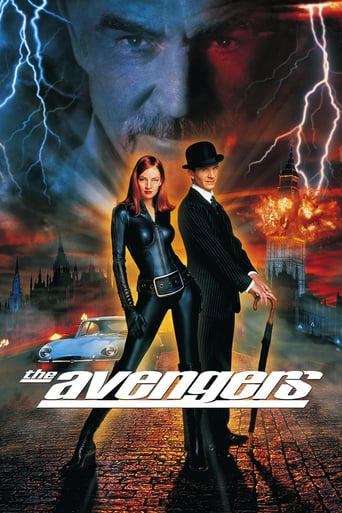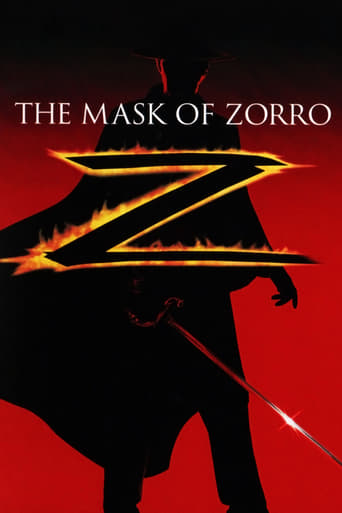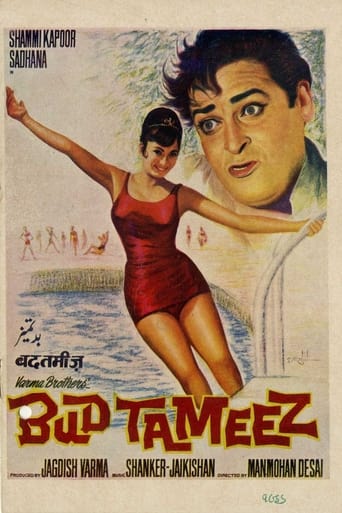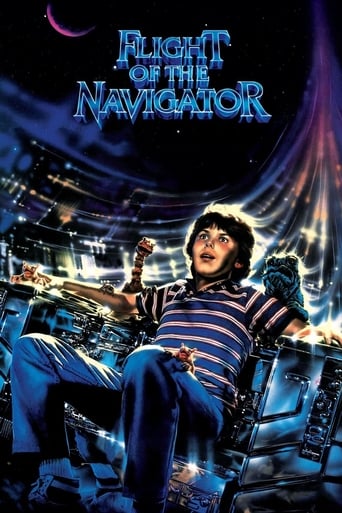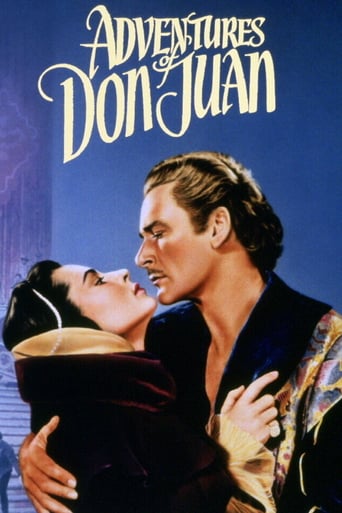
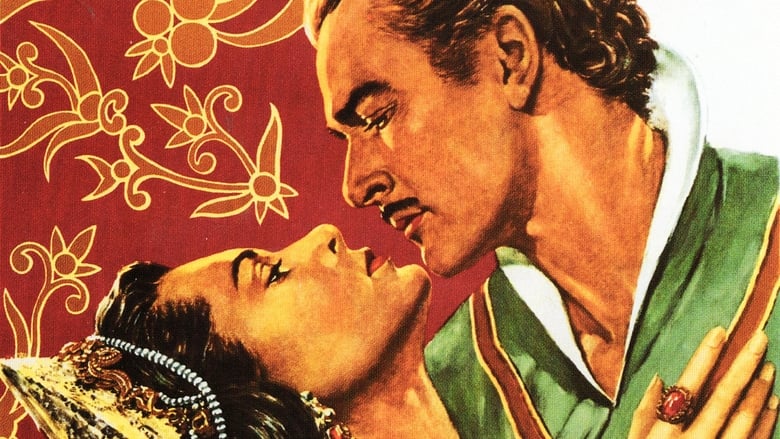
Adventures of Don Juan (1948)
Spanish Lothario Don Juan, the legendary lover and adventurer returns to Spain following a scandal and comes to the aid of his queen, who is under threat from sinister forces.
Watch Trailer
Cast
Similar titles
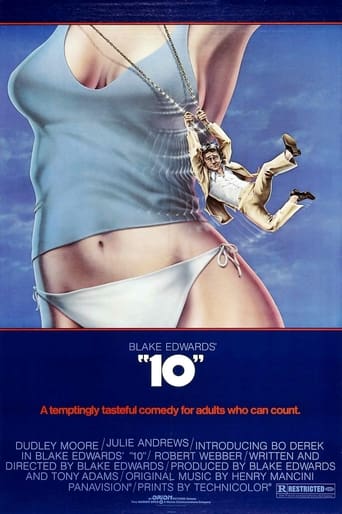
Reviews
Good movie but grossly overrated
An Exercise In Nonsense
Entertaining from beginning to end, it maintains the spirit of the franchise while establishing it's own seal with a fun cast
Good films always raise compelling questions, whether the format is fiction or documentary fact.
Errol Flynn, having played the long beloved mythical rascal-hero Robin Hood a decade earlier, here plays another centuries-old mythical rascal-hero: the legendary seducer of women: Don Juan, albeit in his mature years, when he was ready to curtail his lustful adventures for more practical pursuits. This screenplay is scripted in a historical setting of very early 17th century London and Spain, shortly before the death of Queen Elizabeth. Phillip III(Romney Brent) is king and his Hapsburg wife Margaret(Viveca Lindfors) is queen of Spain. The chief villain is Duke de Lorca(Robert Douglas): chief minister of the Spanish court, supported by Don Rodrogo(Douglas Kennedy) and Alvarez(Raymond Burr), chief of the palace guard. The duke clearly plans to transform the royal couple into puppets so that he can carry out his plans for Spain. Since the queen refuses to cooperate, he is preparing to execute her near the film's ending.In the film, Philip is portrayed as a weak-minded king, dominated by his rather estranged queen and de Lorca, who are at odds with each other over major policies. Clearly, de Lorca is a stand in for the historic Duke of Lerma. Although there is often a measure of historical truth to the characterizations in the film, mostly, they are quite distorted versions of the historical persons they are based upon. The historical king and queen actually got on very well, for the most part: well enough to produce 8 children during the queen's short life(She died during childbirth at only 26). With at least some of these young children, the historic queen wouldn't likely be thinking of abandoning her position and running off with Don Juan, as she briefly fantasized. The Duke of Lerma was actually a good friend of the king, who willingly gave him his very powerful position within his administration. As in the film, the Duke was often at odds with the queen over financial policy. The queen influenced the king to provide financial aid to her native Holy Roman Empire, whereas the Duke wanted to use Spanish revenues only for Spanish purposes. In the film, this conflict is transformed into a conflict between using revenues to promote peace(queen's idea) vs. using it to built up the fleet in preparation for war(Duke's idea). Juan sides with the queen in this conflict. This is the ultimate fencing-dominated film, culminating in the dramatic duel between Juan and de Lorca on the very long palace stairs. Much of it is practice, after the queen demands that Juan become the chief instructor for the royal fencing academy, to give him something useful to do to keep his mind off chasing pretty young things. In one scene, there is a mass choreography of fencing students: the fencing equivalent of a musical chorus dance. Juan engages in a number fencing duels or mock duels throughout the film.For a film about a compulsive seducer of women, there is remarkably little real romance. The film begins with Juan climbing a balcony outside London to reach a lover. What ensues is cartoonish. He is soon chagrined to discover that she has a husband, who unexpectedly arrives, providing Juan's first dueling scene: really a mock duel, in which Flynn goes into his Robin Hood mode. He then lectures the husband about his inadequate attention paid to his wife. Juan and servant Leporello(Alan Hale) then make a fast getaway on horse, to be greeted by a palace patrol, expecting to meet a Spanish duke, coming to marry. Juan pretends he is this duke, thus is escorted to be introduced to the bride-to-be. A scandal ensues when the real duke arrives to find Juan and the lady alone in a room.... Later, while a fencing instructor, one of the court ladies makes an obvious pass at him, which he reluctantly follows up. Again, he discovers she is to be married the next day, her husband showing up to creating another scandal... The final scandal is when the Queen and Juan discover they love each other, heightened by Juan saving the Queen from de Lorca's planned execution. She even talks of running off with him, but Juan says her duty to Spain is more important than their love. An in joke is that in the final frames, Juan decides to chase after a coach containing Flynn's then wife, having vowed to abstain from chasing women.Obviously, the screen play exploits Flynn's reputation as a compulsive skirt chaser. Also, clearly, much expense was put into the elaborate costumes and sets. Max Steiner, taking over from Wolfgang Korngold as the traditional composer for Flynn films, did a fine job. Actually, I believe the film would have fared much better at the box office, if it had been made into at least a semi-musical. The film was not a box-office success in the US, although it did better in Europe. Hence, the Warner budgets for future Flynn films were slashed. Flynn still looked and acted relatively youthful at age 39. As he turned 40 or so, his drug excesses would show up much more clearly in his looks and performances. However, he wasn't quite done swashbuckling. For example, he starred in yet another sea pirate film: "Against All Flags", 4 years later, where he, perhaps with the aid of doubles, engages in several ferocious duels, clearly laboring where formerly he made it look easy.This same year, MGM released another classic tale of swordplay and romance in "The Three Musketeers", starring Gene Kelly.
The most eagerly awaited Flynn movie has at last made it to DVD! Unavailable for some years except on a VHS tape and an obscure over priced Korean disc it, thankfully, is back in the Warner Bros. stable where it belongs. The wait was worth it for the disc is simply pluperfect! With rich vibrant three-strip Technicolor and sharply defined images it is a joy to behold! Flynn is terrific in the title role of the great lover and roue. Not withstanding perhaps a nod to the actor's own lifestyle the part was nevertheless taylor made for him. And although it was said at the time that he was slowing down and that he hit the booze while filming there is no evidence of it on screen. The great swashbuckler cuts a fine figure in his many fabulous costume changes throughout the picture. These costumes - designed by the great Travilla - won the 1948 Acadamy Award for best costume design.The supporting cast were well chosen too! Robert Douglas is great as Flynn's adversary - the evil Duke DeLorca. His dark eyes blackened even more to make him look that bit extra villainous. Alan Hale is once again Flynn's faithful sidekick but after 12 movies this was to be their final picture together. He died the following year. The female lead is taken by the beautiful Swedish actress Vivica Lindfors. Here she plays Margaret Queen of Spain and the one true love of Juan. Lindfors' final film was "Stargate" in 1994! She died in 1995 at the age of 75."The Adventures of Don Juan" is well directed by Vincent Sherman and is probably his best remembered movie. The atmosphere, the colour and the sets in the court scenes are really very impressive. But now and then the film gets a little bogged down with some palace intrigue until the picture's famous set piece - the brilliantly staged sword-fight on the magnificent palace staircase. It ranks as one of the cinema's finest duels and Flynn will always be remembered for it even though that amazing leap with the knife was performed by stuntman and B picture actor Jock Mahoney.Then, of course there is the music by Max Steiner - one of his very best scores! Particularly splendid is his music for Juan's Parade into London with its masterful use of bells and chimes. Also the wistful Ballade which accompanies Juan on his many and various balcony climbings, the driving action music for the fight in the palace and the gorgeous love theme for the scenes with Juan and the Queen especially for the sequence near the end. Here the theme is heard in full bloom as the lovers say farewell to each other forever ("I shall be the only one who knew, for just a little while, that there was no Queen"). Interestingly Flynn's usual swashbuckling composer Erich Wolfgang Korngold - who had served him brilliantly on past successes such as "Captain Blood", "The Adventures Of Robin Hood" and "The Sea Hawk" -was originally slated to score "The Adventures Of Don Juan" as far back as 1945, but by the time the picture went into production the esteemed composer had left Hollywood and returned to his birthplace Vienna. As brilliant a composer as Korngold was it's difficult to imagine he would have topped Steiner's exceptional score. But alas we will never know!So quite a wonderful disc all round with good extras consisting of a commentary by director the late Vincent Sherman and Flynn authority Rudy Behlmer, a trailer and some instantly forgettable old fashioned shorts but the movie is all, so enjoy. En Garde!
Errol Flynn is back in swashbuckling costume eight years after the excellent "The Sea Hawk", and it feels like he never went away. I was expecting this film to be not that good, and I imagined Flynn as looking tired and puffy as a result of his wild lifestyle. However, I was pleasantly surprised. It's a wonderful piece of entertainment. Of course, the plot is really no different from any other swashbuckler, but it's still a heck of a lot of fun. Flynn is perfectly cast as Don Juan- really, who else can you picture but the Tasmanian Devil in the role? This film is about Don Juan in love, with his Queen (a suitably regal Viveca Lindfors), and putting his life on the line for Spain. Aside from the natural ageing process, and looking a little puffy around the face, Flynn is as attractive, charming and witty as ever. Alan Hale, his sidekick in many of his previous films, joins in again. He's Don Juan's loyal friend who keeps the horses under the boudoir window so Flynn can make a quick get-away if a jilted husband bearing a sword arrives. We even have Una O'Connor there, which makes us all sigh and remember Robin Hood. The Warners team do a great job in creating a fresh new swashbuckler for more cynical Post-War audiences (Flynn character is more knowing and sarcastic, but in a good way), whilst being an affectionate tribute AND send-up to the earlier great classics. I guess Warners capitalised on news of Flynn's rape trial and reports of his hedonistic lifestyle in creating this film. But Flynn seems to take it in good humour. The costumes, sets and colour are first rate, as is Max Steiner's stately score. And the last line is a classic!
This was Flynn's last big one. He was only 38 at the time but had begun drinking in the afternoon, causing problems on the set, what with multiple retakes and a major binge that lasted several weeks. It's not "The Sea Hawk" or "Robin Hood." Still, the film was artfully edited and clearly a lot of money was spent on it. The Technicolor photography is outstanding and nobody ever looked quite so natural in a gaudy period outfit as Flynn. It holds one's interest.The story has Flynn as Don Juan, lover and swordsman, returning to Spain at the beginning of the 1600s. It's really a pastiche, kind of like "The Sea Hawk" with elements introduced from various other films of the genre. There's the well-intentioned Queen, the beautiful Viveca Lindfors of the plump lips and strong features, surrounded by weaklings and traitors who want to go to war -- except for Don Juan, of course. (Cf., "The Sea Hawk.") There's the comic sidekick, Alan Hale. (Cf., all of Flynn's Warners pictures.) The good guys disguised as hooded monks. ("Robin Hood", "The Mark of Zorro.") The hero and villain, face to face and belly to belly, straining at their crossed swords, and the villain sneakily withdrawing a dagger from his belt ("Robin Hood"). The hero captured and thrown into prison to await execution, only to make a spectacular escape. ("Robin Hood", "The Mark of Zorro.") Shadows fighting on the castle wall. ("Robin Hood," "The Prisoner of Zenda".) And so on. Some shot are edited in that are taken directly from "Robin Hood" and "Elizabeth and Essex." Robert Douglas is Duke de Lorca, the heavy. He makes a slimier heavy than Basil Rathbone did. Douglas is okay but Rathbone was a nonpareil with his tall figure, abrupt movements, and darting glances. Perc Westmore was responsible for the make-up. He should be proud of himself for the task with which Flynn must have presented him. But he should be ashamed of himself for what he did to the villains. You know how you can tell the principal villains from everyone else? They all have dark eye shadow, so they look like the ghouls or zombies in a Grade C horror flick. Douglas has this sinister curl down the middle of his forehead that looks painted on.The director, Vincent Sherman, doesn't seem to have compelled any of the performers to act with any subtlety. It's not that kind of movie. But everyone is professionally competent. Alan Hale -- well, it's as if he were your fond uncle. Viveca Lindfors probably puts the most effort into her work. When Flynn enters her life she becomes positively, and literally, breathless. And watch the fleeting expressions that cross her features when Flynn confesses his love for her -- the briefest of half-hopeful smiles followed by a scowl of indignation.The amours of Don Juan occasion some amusing moments. One of the many young ladies who come to watch him instruct the members of the fencing academy leaves her fan behind. When Flynn calls this to her attention, she replies, "You WILL return it, won't you? It's the house on the Plaza Madrid. The last house on the right." "Oh, on the RIGHT," says a resigned Flynn, who has heard this hundreds of times before.The budgets on Flynn's pictures dropped dramatically after "The Adventures of Don Juan." He chain smoked, used drugs, boozed it up daily, and never complained. He died at the age of 50, having lived as he pleased.
